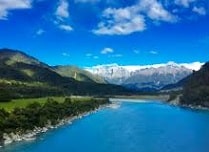The first step we are going to take is to know the etymological origin of the term fjord. In this case, we can state that it derives from Scandinavian, specifically from the word “fjord”, which can be translated as “narrow bay formed by glaciers”.
Therefore, this is the name given to a narrow gulf that emerged from the action of glaciers in the Quaternary period of the Cenozoic era.
 Fjords develop between elevations with steep slopes. These are entrances from the sea into the land that stand out for their depth. In general, the mouths of these gulfs are shallower than the sectors that go further into the coast.
Fjords develop between elevations with steep slopes. These are entrances from the sea into the land that stand out for their depth. In general, the mouths of these gulfs are shallower than the sectors that go further into the coast.
As fjords are formed in regions that, many years ago, were covered by glaciers , they are found in countries and areas such as Iceland , Norway , Scotland , Canada , Patagonia , Alaska and Antarctica , whose latitudes are high.
The Oslofjorden , or Oslo Fjord in our language , is located in southeastern Norway, where the Baltic Sea connects with the North Sea . This fjord has an extension of about 150 kilometers and is home to several islands.
The Moray Firth is the largest in Scotland. It is located in the North Sea and enters the city of Inverness . This fjord has 800 kilometers of coastline.
Sognefjord , or Sogn Fjord , is the widest in Norway . Located in the west of this European nation , its extension exceeds 200 kilometers and reaches a depth of 1,308 meters below sea level.
Of this fjord we can also highlight that one of its arms, specifically the one that responds to the name of Naeroyfjord, has been declared a UNESCO Heritage Site since 2005 and has at its source what is considered the longest glacier in all of continental Europe. . We are referring, specifically, to Jostedal. It has an area of 487 square kilometers and a length of 60 kilometers.
Among the most beautiful fjords on the planet we can highlight some such as the following:
-Saguenay. It is located in Quebec (Canada), has a length of about 100 kilometers and becomes a perfect setting to enjoy watching cetaceans, such as whales.
-Mildford Sound. In South Island, in New Zealand, is where we find this other fjord that is considered one of the most beautiful that exists. It highlights peaks and cliffs that have the peculiarity of being named after animals because their profiles are reminiscent of them. This would be the case, for example, of León, with 1,300 meters, and Elefante, with 1,500 meters.
-Eyre. Chile is where, on the other hand, this other fjord is located, with the Pío XI glacier among its main attractions. Around it are mountains that reach 1,300 meters high as well as two other fjords: Exmouth and Falcon.
Beyond these fjords, the largest on the planet is in Greenland : the Scoresby Sund . Its extension is greater than 350 kilometers and its depth reaches 1,500 meters. Various islands can be found in this fjord.
